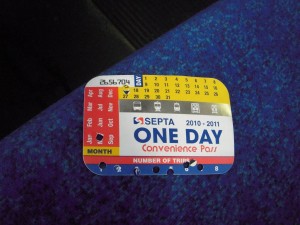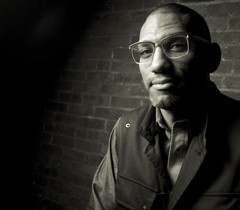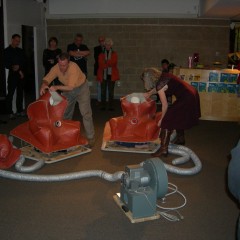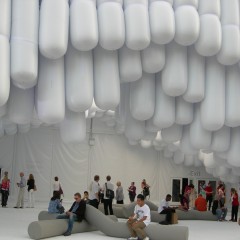“WALKING ON Sunshine,” the newest SEPTA Art in Transit piece on the platforms of the rehabbed Spring Garden station, is unexpectedly cheery and colorful. With its snappy, patent-leather shine, it gives the underground station “soul,” as one appreciative rider put it.
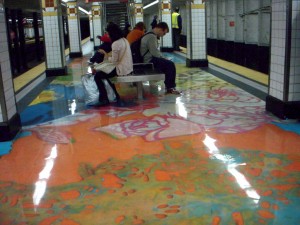
This creation of Philadelphia artist Margery Amdur is one of 21 art projects SEPTA has created systemwide since 1998, when Art in Transit began at the behest of then-new SEPTA general director Jack Leary. Leary came from Boston, which had an art program in its MTA; he wanted art for Philadelphia, too. Everybody up and down the SEPTA line embraced the idea, according to Elizabeth Mintz, who came on board at the same time as Leary and is the authority’s director of communications and manager of the Art in Transit program.
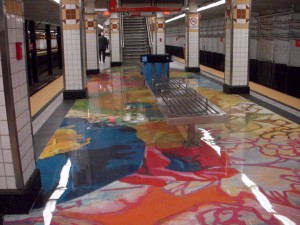
An art program in a transit system may seem superfluous, or even questionable when times are tough financially for mass-transit systems. But funding for Art in Transit comes from the Federal Transit Administration; no city or state money is used. When the Spring Garden station (and the nearby Girard station) renovations qualified as shovel-ready projects for 2010 federal stimulus funds, Art in Transit received FTA funds for both stations. Amdur’s “Walking on Sunshine,” selected from an open call for artists, had a budget of $150,000.
The FTA considers art and design programs one of its important initiatives, right up there with planning and safety. The goal is to build ridership by making stations, bus shelters and other infrastructure attractive to riders. “Good design and art … give vibrancy to a community’s public spaces, and make the public feel welcome,” the agency says on its website. FTA-supported art-in-transit programs exist in 17 other states.
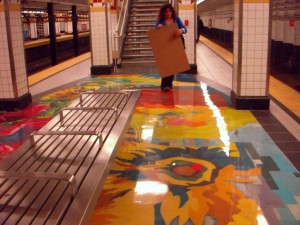
“It’s not just about fine art; it’s a way to develop a conversation with the communities we serve,” Mintz agreed. “Art is a way to build a relationship with the community. When we reconstruct a station, shiny stainless steel and brick goes only so far. We want to get the personality of the community in there. And the art brings in the community.”
Artists must explore the neighborhood around a transit station to discover landmark moments in the community. There are community meetings where input from artists and the public is welcome. “The object is to encourage community ownership,” said Marsha Moss, an independent public art curator and consultant who administers the Art in Transit program with SEPTA. “Public art is two words,” she said. “If it’s not meaningful to the public, it’s not successful as public art.”
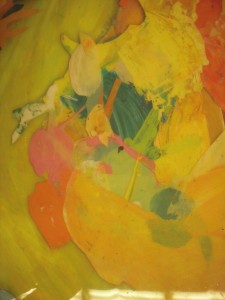
SEPTA’s art projects vary widely from station to station. From mosaics and murals to Amdur’s floor piece, the artists’ individual voices come through loud and clear. “We try very hard not to do the same project over and over,” said Mintz. “We have a list of what we’d like to see — and not just murals and benches.”
Flower power
As an installation artist, Amdur was comfortable working with floors for her project. “In most of my installations, the floor acted as an additional picture plane to work on,” she said. A floor piece conveys a journey. “I want people to get the sense of journey, metaphorically and literally.”
In her studio, Amdur made drawings that were a mélange of flowerlike shapes in various colors and a variety of more hard-edged shapes that overlap and create a sense of space. The piece takes inspiration from Vincent Van Gogh’s sunflower paintings and Andy Warhol’s pop-art sensibility — an improbable combination, but one that works.
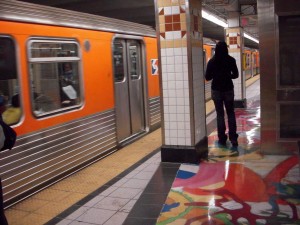
Scaled up 400 percent, printed on special fabric and embedded under layers of shiny resin that was poured on-site, the drawings still have a handmade feel. Along the dreamy, 4,000-square-foot walkway, tropical colors and organic shapes seem to float in layers beneath the glassy surface underfoot.
The floor has a 35-year warranty; a new coat of resin will be applied every five years. Although it looks slick, it isn’t. (The surface meets engineering specs for a public walkway.)
Amdur got lots of “wows” the first day as people thought they were walking on glass. And although many young commuters seemed to be concentrating on their cellphones, Amdur saw their eyes glancing down while they talked. “If I can get eyes roaming the floor before they get on a train, that’s great,” she said.
In a recent email Septa consultant Moss said she hoped “that more and more artists will explore these public venues for their work and become actively involved in community development. There’s a huge audience out there whose lives may be enriched, and there is urban design, both above and below the street, that could benefit from creative solutions.”
For more pictures of Amdur’s piece, see my flickr set.
A rider’s guide to SEPTA’s Art in Transit
IT TOOK SEVEN punches on a SEPTA eight-ride One Day Convenience Pass ($7) to see 10 Art in Transit projects — a three-hour journey on the Market-Frankford and Broad Street lines, with a stop at Suburban Station. Many of the projects are beyond the ticket gates and thus viewable for paying riders only. The projects vary widely and although they all succeed as public art, some can’t compete with SEPTA’s overwhelming infrastructure of walls, exposed beams, platforms, stairways and gates. The best stay true to the artist’s studio practice while adding boldness and whimsy to the transit system. (Note: * indicates a transit ticket is required to see the piece) See my flickr set for complete photos of all these Septa art works.
Margery Amdur
“Walking on Sunshine”* 2012
Spring Garden Subway Station at Broad Street
Pass the ticket gates and walk down the steps to the platform where six separate floor cloths are embedded on the concrete walkways. Rich colors and lush imagery make this an unexpected delight. Poured resin and fabric.
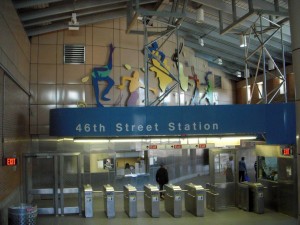
Barbara Jane Bullock
“Dancers” 2009
46th Street Elevated Station at Market Street
Climb the steps (or take elevator) to the floor above street level. Bullock’s large, painted aluminum cutouts of dancing figures sit on the wall high above the ticket window. This joyous piece of art — evoking jazz, mambo and other musical rhythms — more than holds its own in the metal, tile and glass space.
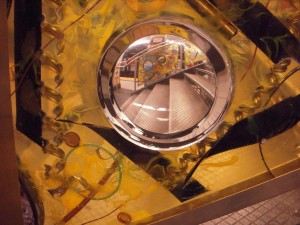
Robert Woodward
“Looking-Glass”* 2012
Girard Street Subway Station on Broad Street
Once beyond the ticket booth, go down the steps and stop on the stairs to see the “windows” inserted below the stair rail on either side. Embedded in the colored resin are materials gathered from the Girard neighborhood, such as photos, metal washers and shavings, glass lenses and mirrors. Be sure to look closely at this surprisingly intimate public work.
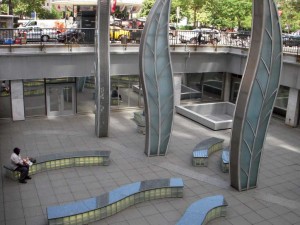
Barbara Grygutis
“Lifelines” 2006
Suburban Station Concourse, 16th Street and JFK Boulevard
Your first sighting of this piece is at street level, where the tips of five glass “leaves” peek out from their underground plaza and suggest shark fins or boat sails. Stand at the observation rail around the space for a great bird’s eye view of the aluminum, glass, light and granite work, and take the nearby steps down to the glass-enclosed sculpture garden for the full effect. Benches accommodate lunchtime crowds, and mirrored glass on the inside of the space enhances the sense of a secret garden.
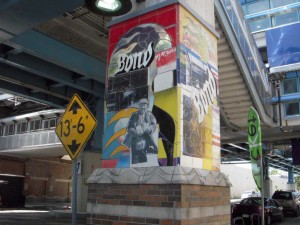
Ed Hughes
“Brighter Moments” 2009
56th Street Elevated Station at Market Street
Four support pillars hold up the El at 56th and Market. Ceramic tiles adorn all four sides of each pillar, with photographic imagery from 100 years of neighborhood history. Up the stairs and past the ticket gates (ticket required), Hughes has adorned several support beams on the platforms with brightly colored ceramic tile that suggests undulating leaves.
Erica and Henry Loustau
“Before, Now, Tomorrow” 2008
“Onward and Upward”* 2008
“Constellation”* 2008
52nd Street Elevated Stationat Market Street
Up the steps (or elevator) at ticket-window level is an abstract, totem-like wall sculpture of a series of colored, powder-coated steel dials, gears and wheels. It’s above the elevator and somewhat invisible in the busy, high-ceilinged space. Beyond the ticket gate (ticket required) and up the steps to the platform are two more sculptures with gears and wheels suggesting transportation and the ticking movement of a watch. The pieces pay homage to a beloved public clock that was once at the intersection.
Richard Goloveyko
“Groundswell”* 2006
8th Street Station, Market-Frankford line
Beyond the ticket gate, walk down to the platform and you’ll be startled by the zany, electropolished stainless-steel benches that seem to float in the space (they are bolted to the walls). Pinched in like a loosely folded piece of paper, they provide a shelf to rest your bags on or lean against. People were doing both when I visited.
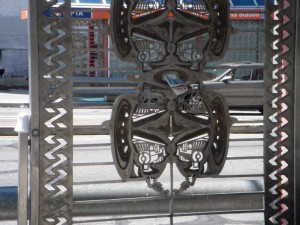
Rafe Ropek
North Philadelphia Transportation Center 2008
Glenwood and Broad Street; also at Lehigh Avenue
At the street-level entrance to the subway station are muscular bronze and steel gates with imagery suggesting Latino masks from the Taino culture. The zigzag border pattern adds finish and suggests you are looking at an art piece, not a decorated gate. The gates are closed at night but open during the day, when they are visible as a kind of louvered grillwork separating the station from the street.
Victor Johnson and David Stephens
“Reflections on 7 Steps to Heaven” 2008
60th Street Elevated Station and Market Street
At street level, look up at the two beams that hold up the El. On the beams, and set at rakish angles, are photographic images of neighborhood history.
Elisabeth Nickles
“Cobbs Creek Constellation” 2011
63rd Street Elevated Station at Market Street
Outside at street level, look up for small steel cutouts of moving figures in bright colors. Inside, ascend the steps and pause midway up for the red, yellow and blue medallion high on the wall, made from more of the metal cutout figures. At the first landing is another medallion-like piece on the wall, with mostly blue figures. n
This article ran in the Philadelphia Daily News on May 22 as part of Art Attack, a partnership with Drexel University supported by a grant from the Knight/NEA Community Arts Journalism Challenge, administered by the Greater Philadelphia Cultural Alliance.


